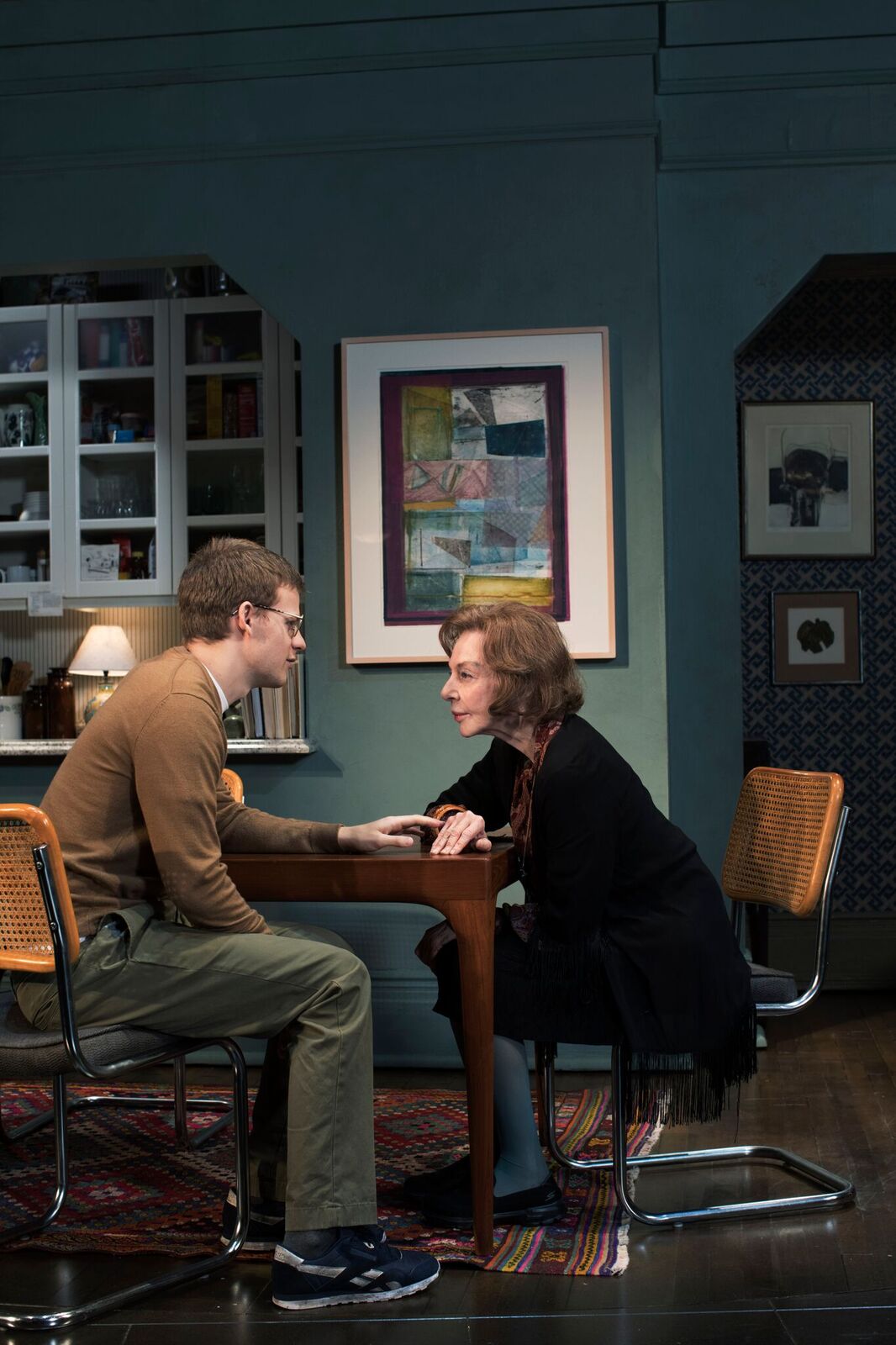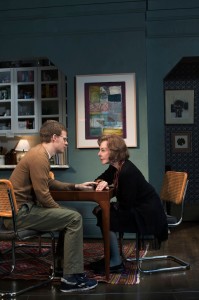
“Do You Know What Meshugge Means?”
Kenneth Lonergan, the accomplished writer known for plays like “This Is Our Youth” and the Academy Award winning screenplay “Manchester By the Sea,” has said that he based Gladys on his own grandmother. “The Waverly Gallery,” first produced Off-Broadway in 2000, was a Pulitzer Prize finalist, and can be seen on Broadway now.

Lucas Hedges and Elaine May in “The Waverly Gallery.” (c) Brigitte Lacombe
“I want to tell you what happened to my grandmother, Gladys Green, near the end of her life,” Daniel says directly to the audience. Hints in the opening scene lead the audience to wonder if Gladys is losing more than her hearing: her memory seems to be slipping as well, with more loss escalating from there.
The play—enhanced by May’s stellar performance—traces in heartrending detail the descent of a smart, kind and vibrant woman into confusion, panic and loneliness. It also demonstrates how those shattering changes affect the people who love her. Though it has many sharply funny moments, “The Waverly Gallery” is an intimate drama tinged with profound sadness, partly because it is so very relatable, especially to those of us who have trouble remembering things. (What was the name of that playwright again?)
One of the most memorable interactions is between Gladys and her son-in-law, who, despite being a psychiatrist who should know better, blurts out, “It’s no fun getting old.” Gladys snaps back with a quick response: “Why do you always say that to me? Nobody wants to hear that! That’s not a helpful thing to say.”
The audience around me gasped, guffawed and applauded extensively. Some people looked as though they were ready to give the outburst a standing ovation, as though Gladys had just delivered a thrilling aria in an opera. (But who can stand up that easily?)
Gladys’s situation reminds us that we don’t have as much control over life as we think. It doesn’t matter that Gladys worked as a lawyer and, in her later life, runs an art gallery (the source of the play’s title) in Greenwich Village. It doesn’t matter that she provides guidance for her grandson and helps a stranger who is a struggling young artist. She won’t be able to stop her deterioration. The pain of these declines is often felt more deeply by women, who tend to live longer.
Gladys’s daughter Ellen, Daniel’s mother, and also a psychiatrist, can’t escape the frustration and irrational rage she feels toward her loquacious and often stubborn mother. Nor can she escape the caretaker role that so often falls to women, no matter the level of their career. Ellen is frequently called upon to cook for family and guests, something she doesn’t enjoy but that even her mother has forced on her: Gladys, proudly, doesn’t cook, though she is glad to have Ellen prepare weekly dinners for her in Ellen’s Upper West Side apartment. With a somewhat more egalitarian impulse, Gladys frequently (because she doesn’t remember she has asked it before) asks Daniel if he can cook. A little, he always answers.
There’s nothing explicitly feminist going on here, yet it speaks to gender roles. Intelligent, thoughtful women (and men) haven’t yet worked out how to untangle all of society’s expectations—and no one has yet figured out how to overcome biological destiny.
May, who is 86, is so deeply embedded in her role that you may wonder if some of Gladys’s ramblings are the actress’s own. Like Gladys, May has had a pioneering career, as an actress, writer and director. As a young child, she sometimes acted with her father in his traveling Yiddish theater. In 1960, she made her Broadway debut in “An Evening with Mike Nichols and Elaine May,” a successful improvisational show. That was her last Broadway appearance until now, since she mostly worked in film, directing “The Heartbreak Kid,” writing “Heaven Can Wait,” and more.
This production’s power can additionally be credited to director Lila Neugebauer, who is making her overdue Broadway debut after many Off-Broadway successes. Neugebauer has identified herself as “a Jewish Upper West Sider and a child of a psychotherapist,” close in background to the characters of the show and to their creator. She captures the rhythms of intensely analytical people who are trying to be humane and good, to each other and the world.
In one scene, the young artist to whom Gladys has generously given shelter, asks of the family, “Are you all Jewish?” Daniel at first answers that he’s half-Jewish, since his birth father was Irish. “But since my mother’s Jewish, that means I’m Jewish—by ancient Jewish law.” His Jewish stepfather accentuates Daniel’s status: “You’re Jewish. You’re Jewish. You’re Jewish.” Finally, after his parents reveal that they’re not religious, Daniel supplies the definitive description: “We’re liberal Upper West Side atheistic Jewish intellectuals.” That gets knowing laughter from many in the audience.
One way to see the play in a brighter light is to think less about Gladys’s sad demise and more about the legacy she and her family helped to produce: a caring, loving and articulate grandson. Toward the end, Daniel—the stand-in for the playwright—says of his grandmother, “Her mind was smashed to pieces, and the person she used to be hadn’t really been around for a long time. But the pieces were still her pieces.”
And then there’s this play, which Lonergan wrote soon after his grandmother’s death. What a wonderful thing for a Jewish grandson to do.
The views and opinions expressed in this article are the author’s own and do not necessarily reflect those of Lilith Magazine.
One comment on ““Do You Know What Meshugge Means?””
Comments are closed.





This sounds like a really good play–esp. for these times when Jews are again facing much anti-Semitism. And none of us is getting any younger!!!!